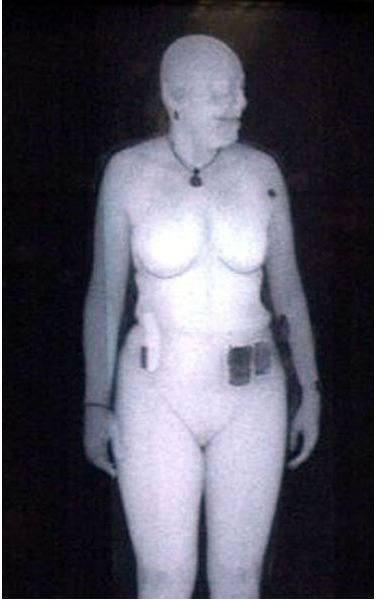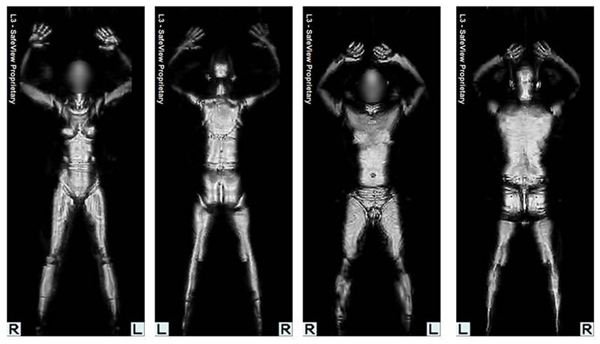Full Body Scan Image Airport Screening - Millimeter Wave Scanning Technology and Backscatter X-ray Machines
Millimeter Wave Scanning
One of the most prominent forms of full body scan image airport screening is the millimeter wave scanner. Using extremely high radio frequencies known as a millimeter wave transmitted from rotating two antennas around a passenger’s body, a three-dimensional image is created and displayed on a monitor. Organic material such as clothing becomes translucent, allowing security personnel to analyze a subject’s body for potential threats. Presently limited to airport screening around the world, the millimeter waves could also be used to scan areas as large as 164 feet (50 m) according to Farran Technologies.
Above right: Millimeter Wave Scan. (Supplied by the U.S. Department of Homeland Security; Public Domain; https://upload.wikimedia.org/wikipedia/commons/d/d8/Mmw_large.jpg)
Backscatter X-ray

Backscatter X-ray machines are another form of full body scan image airport screening used by security personnel in transportation industries around the world. The imaging technology uses traditional X-ray radiation to essentially see a subject’s body through clothing and other material. X-rays are projected onto a subject, the radiation is reflected back from the target and constructed into an image that appears on a screen for security analysis. The benefit of backscatter X-rays over the millimeter wave scanning method is the fact that a full 360-degree platform is not necessary. Subjects can be scanned on one side and then turned to get scanned again on another side.
Like millimeter wave technology, the backscatter X-ray scans can be utilized to observe larger areas. Since the technology does not only work on carbon-based materials, containers and other large objects can also be scanned for security.
Above left: Backscatter X-ray image of woman. (Supplied by the U.S. Department of Homeland Security; Public Domain; https://upload.wikimedia.org/wikipedia/commons/2/2d/Backscatter_x-ray_image_woman.jpg)
Privacy Concerns About Full Body Scans
The main source of push-back against installing and using full body scan image airport screening is the fact that the technology essentially produces a naked image of the subject. This means that screeners have access to nude profiles of people as well as possible confidential medical information. For example, a screener will see if a person uses a colostomy bag.
To address these concerns, the Transportation Security Administration takes a number of provisions regarding its overall policy about the scans. First, the person being scanned is only viewed by a screener located in another location, rather than near the subject. This allows a certain level of anonymity for people. Second, the image is in no way stored in the system. Additionally, the private areas of individuals are blurred using a distortion features available on both systems.
Health Effects of Scanning
Millimeter wave scanning uses terahertz photons to create its images. These do not have enough energy to adversely affect human molecules or atoms. However, the Center for Nonlinear Studies at Los Alamos National Laboratory in New Mexico has shown that these photons can cause detrimental damage to the double helix of DNA. Essentially, too much exposure to these waves could break apart the two strands that compose the DNA, halting [gene expression and replication](/search/results.aspx?q=dna double helix).
However, the radiation level of backscatter X-ray machines is much less dangerous than the millimeter wave scanners. A standard scan bombards the body with between 0.005 and 0.000 millirems of radiation. Humans need approximately 25 millirems of dosage in a single year to suffer adverse effects.
Airport Screening Flaws
Full body scan image airport screening has a number of flaws in the overall system of security. Since certain private areas are distorted, it is possible for subjects to hide weapons or explosives in these areas. The technology is also incapable of scanning the interior of a person’s body. This means that nefarious individuals could utilize body cavities to hide contraband or dangerous items. Also, certain terrorist groups have stated that they will simply place explosives within a person’s body, such as female breast implants, undetectable by either millimeter wave scanning or backscatter X-ray.
Another major problem with the technology is that it makes indecent images of children. Concerns in both the United States and the United Kingdom regarding laws of photographing naked children will have to be addressed in the court of law.
Either way, many transportation facilities around the world have begun installing full body scan image airport screening as one of the many processes to avoid terrorist and other illegal activity.
Resources
“Two Types of Scanners and How They Work” Jaunted: https://www.jaunted.com/story/2010/1/5/163631/3181/travel/Full-Body+Scanners+101:+The+Two+Types+and+How+They+Work
“Q&A: Controversial Full Body Scanning” CNN: https://www.cnn.com/2009/TRAVEL/12/30/airline.terror.scanners/index.html
